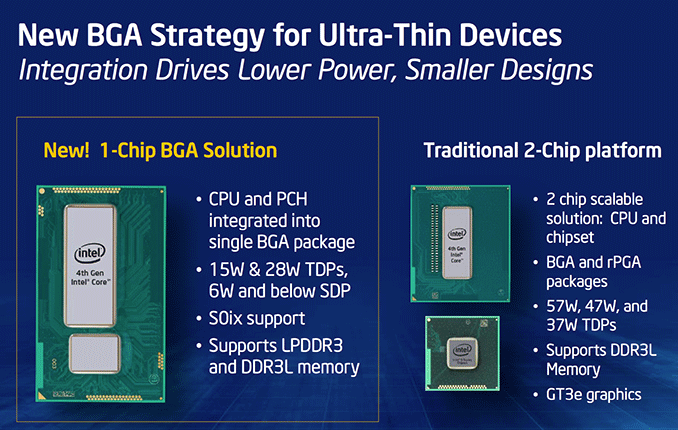The Haswell Ultrabook Review: Core i7-4500U Tested
by Anand Lal Shimpi on June 9, 2013 9:00 AM ESTOn-Package PCH, The First Single Chip Haswell
In 2010, with Clarkdale and Arrandale, Intel went from a 3-chip platform solution (CPU, IOH/MCH, ICH) down to a 2-chip platform (CPU + PCH). With Haswell, we see the first instantiation of a single-chip Core platform.
With the 8-series chipset, Intel moved from a 65nm process on the 7-series chipset to 32nm, skipping 45nm entirely. An older, less mobile-focused Intel would try to keep its chipsets on the oldest, economically sensible node possible, but these days things are different. The move to 32nm cuts TDP down considerably. Intel hasn’t publicly documented the power consumption any of its ultra mobile chipsets, but if we look at QM77 to QM87 we see a 34% decrease in TDP.
In Haswell desktop and standard voltage mobile parts, the 8-series chipset remains a an off-chip solution in a discrete package. With Haswell ULT and ULX (U and Y series SKUs), the 8-series PCH (Platform Controller Hub) moves on-package. Since it’s on-package, the TDP of the PCH is included in the overall TDP of the processor.
Bringing the PCH on-package not only saves space on the motherboard, but it also reduces the power needed to communicate with the chip. Signals no longer have to travel off die, through the package, via traces on the motherboard to the PCH. Instead you get much lower power on-package communication.
Intel also changed the interface between the CPU and PCH to a new on-package interface instead of DMI. Presumably Intel’s OPI is designed for much lower power operation.
Although PCIe support remains on the PCH (6 PCIe 2.0 lanes), there’s no external PCIe interface from the CPU itself. Any hopes for pairing a meaningfully high performance discrete GPU with Haswell ULT are dead. We didn’t see a ton of Ivy Bridge Ultrabooks with discrete GPUs, but the option simply won’t exist this time around. All of the sudden the creation of Intel’s 28W Haswell ULT with GT3 graphics makes a lot more sense. Haswell ULT lacks native VGA support. Update: NVIDIA tells me that it fully supports running a dGPU off of a x4 connection to the PCH. It's not the ideal solution, but discrete GPUs will still technically be possible with Haswell ULT.
Intel adds SDIO support. USB 3 and 6Gbps SATA are both there as well (although with fewer max ports supported compared to the desktop PCH, up to 4 and 3 respectively). There’s also a lot more sharing of bandwidth between individual PCIe lanes and USB/SATA. These limits shouldn’t be an issue given the port/drive configuration of most Ultrabooks.











87 Comments
View All Comments
JDG1980 - Sunday, June 9, 2013 - link
Do Haswell notebook chips have the same crazy high temperatures on full load that the Haswell desktop chips do?dealcorn - Sunday, June 9, 2013 - link
I am not comfortable with your suggestion that DEVSLP's 2 mw benefit shows exclusively/primarily when the system is asleep. I sense a big benefit at low loads because the SSD's can slip in and out of DEVSLP really fact. Let's have some testing, at your leisure. Will a SSD be in DEVSLP state 50% of the time while watching non HD video? I suspect power requirements during DEVSLP is the new idle power measurement for typical home use and SSD reviews should be revised accordingly.Everything else: Bravo!
Sivar - Sunday, June 9, 2013 - link
Typo:"Haswell less than a month after the arrival of a new CEO"
Just trying to help out. :)
kallogan - Sunday, June 9, 2013 - link
What a tech revolution, a bigger battery gives a bigger battery life.FwFred - Sunday, June 9, 2013 - link
Reading is FUNdamental: "Using Acer’s Aspire S7 as a comparison platform and NORMALIZING FOR BATTERY CAPACITY DIFFERENCES I measured anywhere from a 15% to a 60% increase in battery life thanks to the move to Haswell."Emphasis mine.
kallogan - Sunday, June 9, 2013 - link
Scam. A well optimised ivy lap would do the same.Egg - Sunday, June 9, 2013 - link
Proof?Homeles - Monday, June 10, 2013 - link
I see that reading comprehension is not your strong point.kallogan - Monday, June 10, 2013 - link
I just need more than one Haswell based laptop review to draw any conslusions.seapeople - Tuesday, June 11, 2013 - link
Me too. I think Anand should have held any Haswell reviews until we've had a good five years for industry to comprehensively adopt the architecture and fundamentally evaluate the aggregate system stability on an enterprise-wide scale. Then he could submit all the reviews he had saved up.